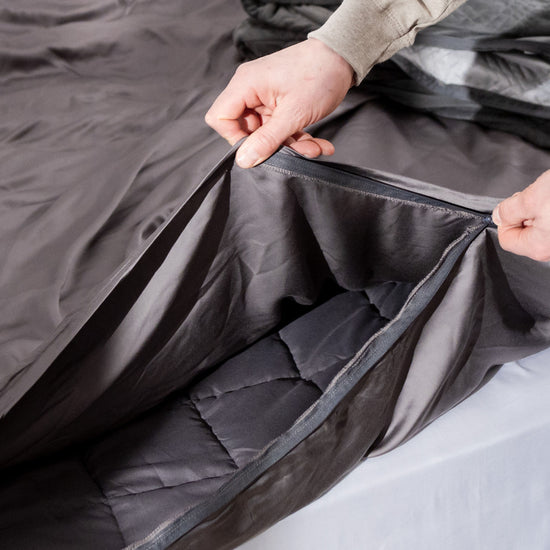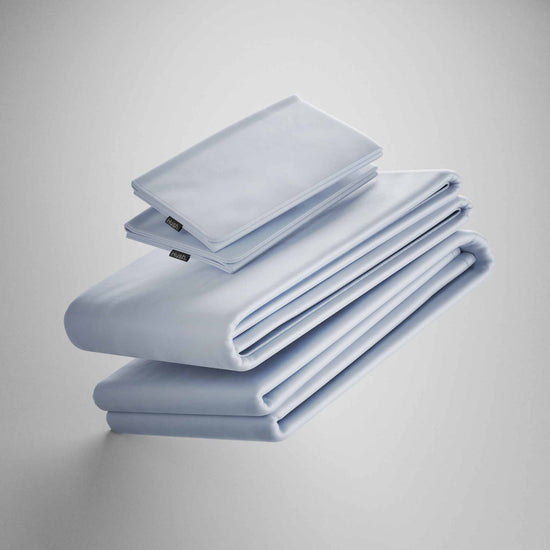In the same way that a high-pressure shower might be the key to ultimate relaxation, a cozy, clean comforter might just be the key to a good night's sleep. However, given that comforters are often incredibly bulky, they can be slightly difficult to keep clean, especially if you don’t have a large washing machine in your home.
But no fret - in this guide, we’re going to take a look at the best practices for washing your comforter, so you can make sure it remains fluffy, fresh, and perfect for cozying up with after a long day. Let’s dive in!
How Often Should I Wash My Comforter?
In general, there’s no strict limit on how often you should or shouldn’t wash your comforter - you can usually see when it needs a wash by giving it a quick once-over and checking for any stains, marks or odours. That being said, it’s a good rule of thumb to wash your comforter once every 1-2 months to keep it fresh.
However, you should also take into consideration how often you use your comforter when deciding how often you’ll wash it. For example, if you substitute your duvet cover with a comforter and sleep with it nightly, you might want to wash it more frequently; oils, dirt, bacteria and other grime can accumulate on the fabric (especially if it’s a low-quality fabric) and can transfer onto your skin. That said, some materials - such as those used for a bamboo king duvet cover - might not need to be washed as often, due to their antibacterial and sweat-wicking properties.
It’s also noteworthy to mention that if you have pets - and they walk or sleep on your comforter - more frequent washing is likely a good idea. And if you’re unsure, you can always take a look at our guide on how to wash a duvet cover for our expert tips and guidance on washing your bedding.
How to Wash a Comforter in a Washing Machine
If you’ve got a washing machine at home, cleaning your comforter is actually quite a hassle-free process. Here's how to wash a comforter in a washing machine without damaging the fabric:
Choose the Right Washer
Ensure your machine is large enough to accommodate the comforter without cramming it, which can cause wrinkles in the fabric and put unnecessary pressure on the filling inside. A front-loading or high-capacity top-loading washer is ideal for this, which you can find in almost any high-street laundromat in Canada.
Select the Appropriate Setting
The best setting for a soft comforter is a gentle or delicate cycle, combined with a mild detergent. Always avoid washing the entirety of your comforter with a harsh stain-removing detergent, as this can damage the fabric and filling. Instead, you can spot-treat stains separately as part of the cleaning process.
Use Cold or Warm Water
If you’ve ever wondered: “what temp should I wash my comforter with?” Go for cold or warm water to prevent shrinkage and preserve the fabric's integrity.
Tips for Washing a Large Comforter

For larger comforters, try these tips:
- Use a Commercial Washer: For oversized comforters, it might be a better idea to use a commercial washer at a laundromat, as your comforter will have more space and power to get cleaned effectively.
- Avoid Overcrowding: Whether you’re washing it at home or in a laundromat, ensure there's enough space for the comforter to move freely in the washer. Take out extra clothes or textiles if it feels like you’re having to cram things in.
- Distribute Evenly: Place the comforter evenly in the machine to avoid imbalance during the wash cycle.
How to Dry a Comforter
After the washing process, your job isn’t quite finished yet! You need to know how to dry your comforter to maintain its fluffiness, shape and longevity - in fact, how you approach drying is, in some ways, as important as the washing itself:
Remove Excess Water
First, begin by gently pressing out any excess water from the comforter, making sure you’re not pressing hard enough to damage the filling. Wringing out your comforter might seem like the easiest option here but it’s not something we recommend, as it can lead to the filling becoming misshapen or clumped.
Avoid Excess Heat
When it comes to selecting a drying temperature, opt for a low heat setting to prevent any damage to the fabric or filling. This is because high heat can be too harsh and may lead to deterioration of the fabrics, and can also damage any adornments or detailing you might have on your comforter.
Use Dryer Balls
Adding dryer balls or clean tennis balls to the dryer can be beneficial when it comes to maintaining the integrity of your comforter’s filling: dryer balls help in evenly distributing the filling and fluffing up the comforter as it dries. This step can be particularly helpful for down or feather-filled comforters, which are prone to clumping.
Ensure Dryness
When it comes to avoiding mould and mildew, you need to make sure that your comforter is completely dry before putting it back on your bed or storing it away in your cupboard. Any residual dampness will encourage the growth of mildew, which is detrimental to both the comforter and your health. If in doubt, give your comforter some extra drying time before putting it away.
Air Drying
For those without access to a large enough dryer, air drying can still be an effective alternative. For this, lay the comforter out flat in a well-ventilated area, away from direct sunlight. Make sure it is spread evenly to avoid moisture pockets that can lead to mildew, and let it dry overnight. And voila, you’re done!






